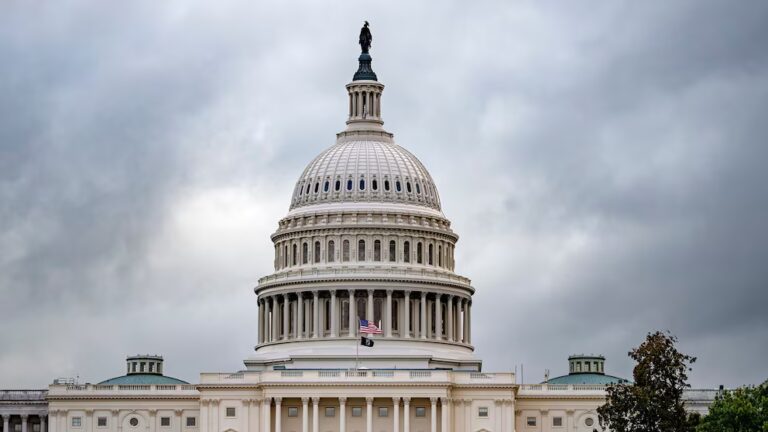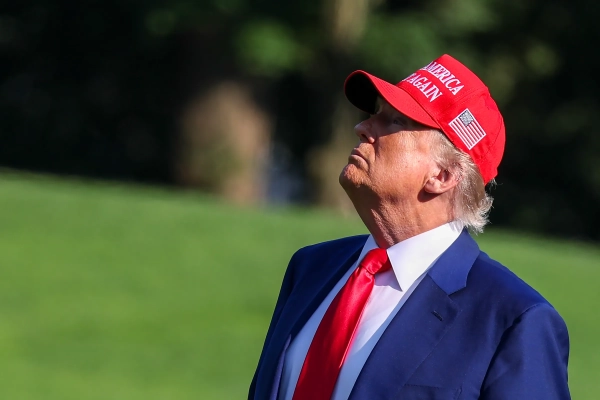Nearly three years ago, as the COVID-19 pandemic forced people from jobs, businesses shuttered and the Trump administration attempted to stave off economic turmoil, White House officials made the decision to temporarily pause all student loan repayments without penalty and accruing interest.
But that temporary pause, which has been extended eight times since, has proven to be far more permanent than intended. And how to move forward out of the pause has become such a politically fraught topic that it will land at the Supreme Court this week.
President Joe Biden, who campaigned on forgiving up to $10,000 per borrower during his 2020 campaign, and was under growing pressure to both deliver on his promise and lift the payment pause, in late August finally announced that he would do so.
The plan was to invoke emergency powers because of economic hardship endured from the pandemic and forgive $10,000 in student debt for all borrowers who made less than $125,000, or $250,000 as a married couple, and up to $20,000 for borrowers who had also received Pell grants while they were in school. (A Pell grant is a small government grant for low-income families.)
Up to 95% of borrowers would have some amount of debt canceled, the White House said.
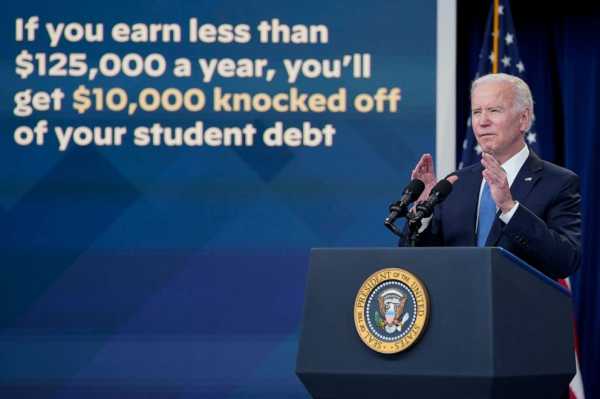
President Joe Biden speaks about the student debt relief portal beta test in the South Court Auditorium on the White House complex in Washington, Oct. 17, 2022.Susan Walsh/AP, FILE
MORE: Supreme Court case against Biden student debt relief could hinge on Missouri
In part, the White House billed it as a carrot to ease Americans back into loan repayments that they'd been exempt from for nearly three years. Department of Education officials cited data that borrower default rates have gone up twenty-fold following natural disasters in the past, arguing that the debt relief after the pandemic was supposed to avoid a historically large increase in delinquency and defaults.
But a month later, lawsuits from conservative groups that opposed debt relief started taking hold — and chipping away at the program.
In late September, a cohort of six Republican states sued the Department of Education for the plan: Arkansas, Iowa, Kansas, Missouri, Nebraska and South Carolina. The attorneys general argued that it exceeded the administration's authority, unfairly excluded Americans who won't receive debt relief or never took out loans and, chiefly, that certain loan servicers would lose revenue because of it. Another court case in Texas, brought by the conservative Job Creators Network Foundation, also took aim at the plan.
Biden, who was in the midst of campaigning for the midterm elections, maintained that the program was legal and would prevail. At the same time, millions of Americans applied for the relief through the Department of Education's website, proving its popularity.
"As soon as I announced my administration's plan on student debt, they started attacking it, saying all kinds of things. Their outrage is wrong and it's hypocritical," Biden said about Republicans at an October rally at Delaware State University. "We're not letting them get away with it."
"I'm completely confident my plan is legal," Biden reiterated in a video on Twitter in late November.
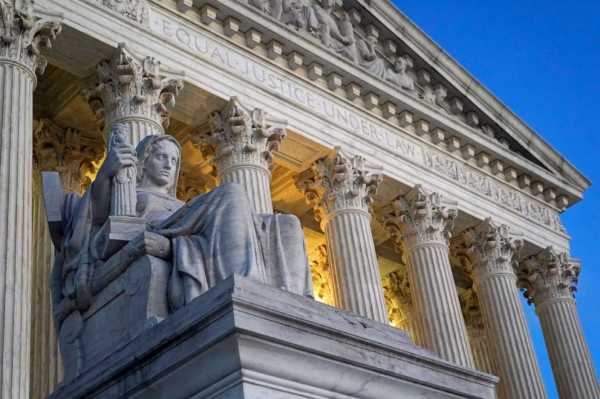
Light illuminates part of the Supreme Court building on Capitol Hill in Washington, Nov. 16, 2022.Patrick Semansky/AP, FILE
MORE: Biden's student loan plan could reduce how much people pay and for how long
But while early court cases against the program were thrown out for lack of standing — that is, for lack of someone or some entity showing they were harmed by it — the subsequent challenges from the GOP were more successful.
Three Republican-appointed judges on the Eighth Circuit Court of Appeals agreed with the GOP argument that Missouri would be harmed because a state-created company called MOHELA, which manages student loans, would lose money if debts were canceled. The attorneys argued that if Biden's student loan program decreased revenue for MOHELA, it would then cut into Missouri's own budget for public colleges and universities.
The application for debt relief was shut down shortly after, in mid-November — despite confidence from the White House and legal experts who argued that there was still no legal standing for those who opposed the plan, even if they disagreed with it politically, because MOHELA wasn't strongly tied to the state of Missouri.
The Biden administration brought that argument to the Supreme Court a week after the application shut down.
By that point, 26 million borrowers had already applied and 16 million were approved for cancellation, but no debt relief had been discharged.
Arguments were set for Feb. 28, on an expedited timeline.
As the administration prepared for the case, Biden announced the eighth and final extension of the payment pause, reassuring borrowers that payments would not begin again until the fate of the program is decided, rather than on Jan. 1, as originally planned.
Student loan payments are now expected to resume either 60 days after the Supreme Court issues a decision on the relief program, or 60 days after June 30 — whichever comes first.
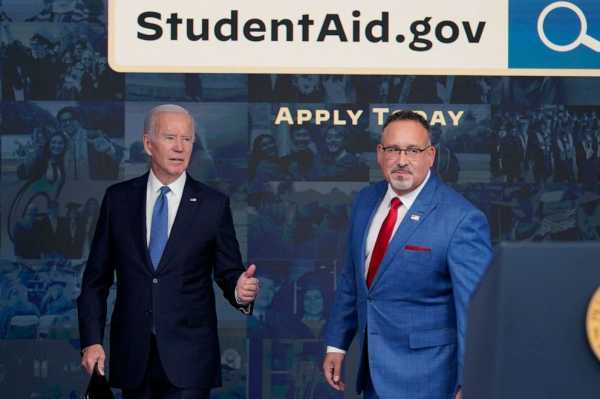
President Joe Biden answers questions with Education Secretary Miguel Cardona as they leave an event about the student debt relief portal beta test in the South Court Auditorium on the White House complex in Washington, Oct. 17, 2022.Susan Walsh/AP, FILE
MORE: 171 Republican lawmakers join effort to stop student loan forgiveness program
Timeline
March 20, 2020
Former President Donald Trump announces the first federally mandated pause on student loan payments for 60 days (the pause started retroactively on March 13).
Inauguration 2021
After taking office, President Joe Biden directs the Department of Education to extend the pause on federal student loan repayments through September of that year.
Aug. 24, 2022
After a total of seven pauses over nearly three years, Biden announces sweeping student loan forgiveness for over 40 million Americans and extends the moratorium until December 31.
Sept. 27
The first lawsuit to challenge the student debt relief plan is filed in Indiana, but is later thrown out for a lack of standing.
Sept. 29
Six Republican-led states sue the Biden administration. Meanwhile, the Department of Education updates guidance on its studentaid.gov site on who qualifies for debt relief to shore the plan up against growing legal challenges.
Oct. 10
The conservative-leaning Job Creators Network Foundation files a lawsuit against the administration in Texas.
Oct. 14
The education department releases a "beta" version of the student debt relief application at studentaid.gov. Borrowers start to apply online.
Oct. 21
The Eighth Circuit Court of Appeals decides to temporarily block the student debt relief plan, forcing the Department of Education not to discharge any debt relief to the millions of applicants until the fate of the program is more thoroughly reviewed and decided in court. People can continue to apply.
Nov. 3
The administration announces that 26 million borrowers have applied for debt relief in the first three weeks of the program. Of those applicants, 16 million have been approved for debt cancellation.
Nov. 10
A federal judge in Texas blocks the program, ruling that it goes beyond the authority of the education department and the power of the executive branch. The Department of Education is no longer allowed to accept applications for debt relief.
Nov. 11
The education department's website stops accepting student debt relief applications.
Nov. 18
The Biden administration files with the Supreme Court to overturn the "stay" on the student debt relief plan in the Eighth Circuit Court of appeals.
Nov. 22
As the legal challenges mount, putting the debt relief plan in jeopardy, and the payment pause deadline of Dec. 31 nears, the Biden administration extends the moratorium again. This time, until 60 days after June 30, 2023, or 60 days after the Supreme Court's decision on the fate of the program (whichever comes first).
Dec. 1
The Supreme Court announces it will hear oral arguments on the fate of the program in its upcoming session. Biden v. Nebraska, et. all will feature the six GOP-led states.
Dec. 12
The Supreme Court announces it will also hear oral arguments in the challenge brought by the Job Creators Network Foundation.
Jan. 4
The administration files a defense of its student debt relief plan with the Supreme Court. The court will hear arguments in opposition of the program from both the six GOP-led states and the Job Creators Network Foundation.
Jan. 11
A coalition of student debt relief advocacy groups file amicus briefs in support of the president's plan.
Feb. 3
More than 170 Republican lawmakers from the U.S. House and Senate file amicus briefs of their own in opposition to the program.
Feb. 28
The Supreme Court hears arguments from the administration, the six GOP-led states and the Job Creators Network Foundation.
Sourse: abcnews.go.com

